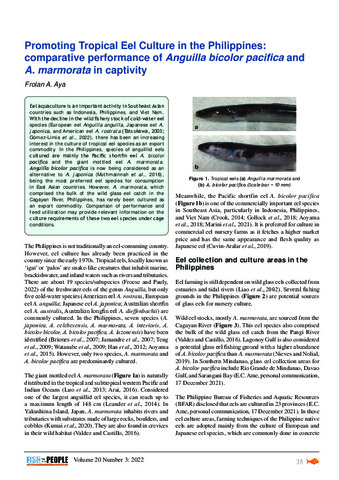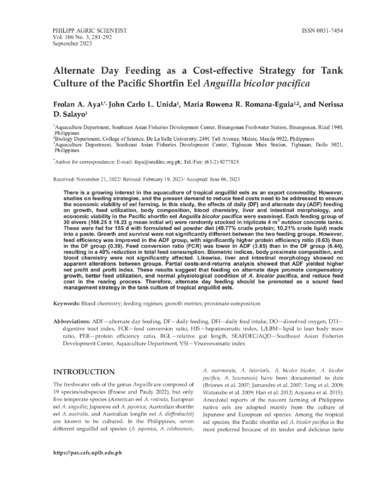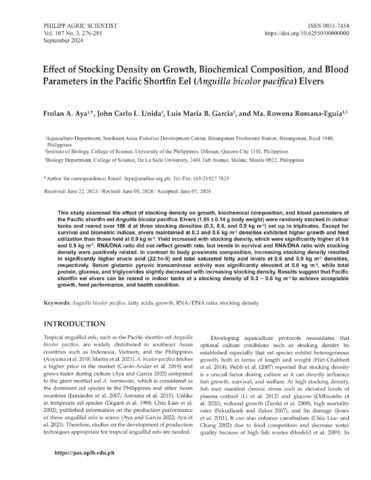| dc.contributor.author | Aya, Frolan | |
| dc.contributor.author | Garcia, Luis Maria | |
| dc.date.accessioned | 2022-09-16T07:10:25Z | |
| dc.date.available | 2022-09-16T07:10:25Z | |
| dc.date.issued | 2022-11-02 | |
| dc.identifier.citation | Aya, F., & Garcia, L. M. B. (2022). Cage culture of tropical eels, Anguilla bicolor pacifica and A. marmorata juveniles: Comparison of growth, feed utilization, biochemical composition and blood chemistry. Aquaculture Research, 53(17), 6283-6291. https://doi.org/10.1111/are.16101 | en |
| dc.identifier.issn | 1355-557X | |
| dc.identifier.uri | http://hdl.handle.net/10862/6366 | |
| dc.description.abstract | This study examined the performance and suitability of two tropical anguillid eels, Anguilla bicolor pacifica and A. marmorata, under cage culture conditions. Juvenile eels (1.73 ± 0.14 g body weight) of each species were stocked in triplicate hapa net cages (1 × 1 × 1.5 m; 30 eels/cage) suspended in outdoor tanks. Growth, feed utilization, biochemical composition and blood chemistry of the two species were compared after 210 days. Except for survival, mean final body weight (FBW), weight gain percentage (WG), specific growth rate (SGR) and yield of A. bicolor pacifica (64.51 ± 13.07 g, 3514 ± 690%, 2.14 ± 0.12%/day, 1534 ± 380 g/m3) were significantly higher than that of A. marmorata (7.77 ± 2.90 g, 356 ± 125%, 0.89 ± 0.16%/day, 178 ± 89 g/m3). In comparison with A. bicolor pacifica, significantly lower feed intake (FI), feed efficiency (FE) and protein efficiency ratio (PER) observed in A. marmorata suggest the need to develop eel diets with feeding stimulants to improve feed acceptance. Biometric indices, body proximate and amino acid composition were not significantly different between the two species. However, serum glutamic oxaloacetic transaminase (GOT), glutamic pyruvic transaminase (GPT) and total protein (TP) in A. bicolor pacifica were significantly higher than that in A. marmorata. These findings suggest that the differences in growth performance and feed utilization between the two anguillid eel species are related to feed palatability, and that A. bicolor pacifica appears to be a suitable species for cage culture because of its faster growth. | en |
| dc.description.sponsorship | The Japan-ASEAN Integration Fund provided funds for the conduct of this study (Study code: Br-02-Y2018B). | en |
| dc.language.iso | en | en |
| dc.publisher | Wiley | en |
| dc.subject | Anguilla marmorata | en |
| dc.subject.lcsh | Eels | en |
| dc.title | Cage culture of tropical eels, Anguilla bicolor pacifica and A. marmorata juveniles: Comparison of growth, feed utilization, biochemical composition and blood chemistry | en |
| dc.type | Article | en |
| dc.citation.volume | 53 | |
| dc.citation.issue | 17 | |
| dc.citation.spage | 6283 | |
| dc.citation.epage | 6291 | |
| dc.citation.journalTitle | Aquaculture Research | en |
| dc.subject.asfa | eel culture | en |
| dc.subject.asfa | cage culture | en |
| dc.subject.asfa | tropical fishes | en |
| dc.subject.asfa | growth | en |
| dc.subject.asfa | amino acids | en |
| dc.subject.asfa | feed conversion efficiency | en |
| dc.subject.asfa | biochemical composition | en |
| dc.identifier.essn | 1365-2109 | |
| dc.identifier.doi | 10.1111/are.16101 | |
| dc.subject.scientificName | Anguilla bicolor pacifica | en |
| dc.subject.scientificName | Anguilla marmorata | en |
| local.subject | amino acid composition | en |
| local.subject | Anguilla bicolor pacifica | en |
| local.subject | Anguilla marmorata | en |
| local.subject | growth | en |
| local.subject | tropical eels | en |



